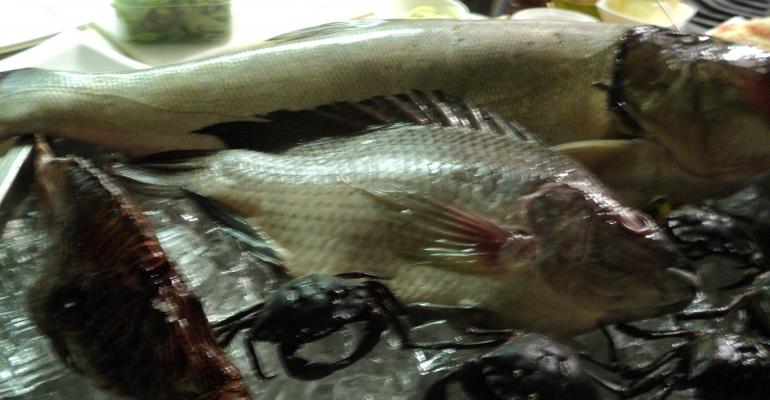Don’t want invaders in your home? Why not kill them and eat them?
That’s the approach that consumer activist group Food & Water Watch is taking with three species of fish and a crustacean that have encroached on American waters.
In the picture are, from top to bottom, Asian carp, blue tilapia and lionfish, as well as green crabs.
Lionfish actually look much sexier before their exotic and poisonous spines have been removed, but Kerry Heffernan, the executive chef of South Gate Restaurant and Bar in New York City, had already removed them by the time I got to the James Beard House, where Food & Water Watch was doing a presentation on ”exotic invasive species” and how to eat them.
I don't think their point was to actually eradicate the invaders. Indeed, local sport fishermen in the Northeast like green crab because it's good bait for blackfish.
I think what they really wanted to point out was that there’s lots of tasty seafood in our waters, and it would make sense if we stopped overfishing the popular ones and relied less on imports — which Food & Water Watch said accounted for more than 80 percent of the seafood we eat — and instead chowed down on the stuff we have in surplus.
Ironically, the fish wasn't easy to procure and Heffernan had roughly 27 hours to figure out what to do with what they gave him.
They had to charter a boat in North Carolina to catch the lionfish. A seafood supplier told them that wild, or blue, tilapia was actually unavailable in the U.S., but they managed to find it at the Fulton Fish Market for $1.75 a pound.
The green crab was provided by New England fishermen after they finished scratching their heads wondering why anyone would want them.
But the results were good. Heffernan used the carp to make a tasty escabeche, pictured here. It was a labor-intensive preparation, though, because, as Heffernan said, “It's almost like the fish was designed not to be able to get at the meat.”

Loopy bones arched out from the spine into the flesh, and then looped off in other directions, making for a labor-intensive process. I asked Heffernan if the labor in preparing the fish would make it cost-prohibitive in restaurants and he said that if the fish itself were inexpensive enough, it might be worth it.
My favorite was the green crab, which Heffernan made into a light bisque. He was impressed with the flavor of the meat, which to him tasted crabbier than blue crab. There was a preparation challenge for that animal, too, as there’s not a lot of meat per crab, so picking out the meat is a time-consuming process.
There was no problem with the lionfish, as long as you remove the poisonous parts.
But Heffernan’s favorite was the tilapia, which was firm enough that you could slice it after cooking it, and it had great body and flavor.
Eating under-utilized fish isn’t a new concept, but it is catching on. At the International Corporate Chefs Association summit that I went to in Seattle last week, one of the speakers was John Sackton, editor and publisher of seafood.com. In the face of rising seafood prices and less-than-stable supply, he recommended to the chefs at chain restaurants and onsite operations who attended the summit that they be flexible in the choice of seafood they put on the menu, changing those choices as supply and price demanded.
He wasn’t talking about Asian carp or lionfish, but he was advocating for a flexibility to which chain restaurants are becoming increasingly accustomed.
Skeptics might want to remember that monkfish used to be considered unfit for consumption and that decades ago, North Atlantic fishermen threw away bluefin tuna until the Japanese pointed out that they actually enjoyed eating them, possibly more than anything else.
Contact Bret Thorn at [email protected].
Follow him on Twitter: @foodwriterdiary

